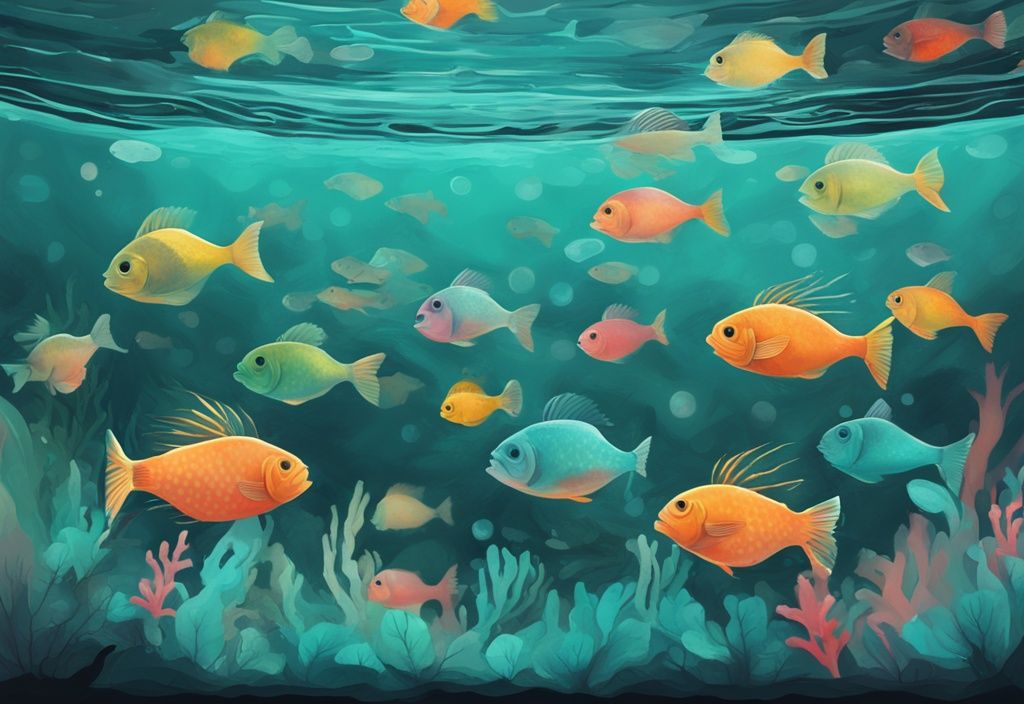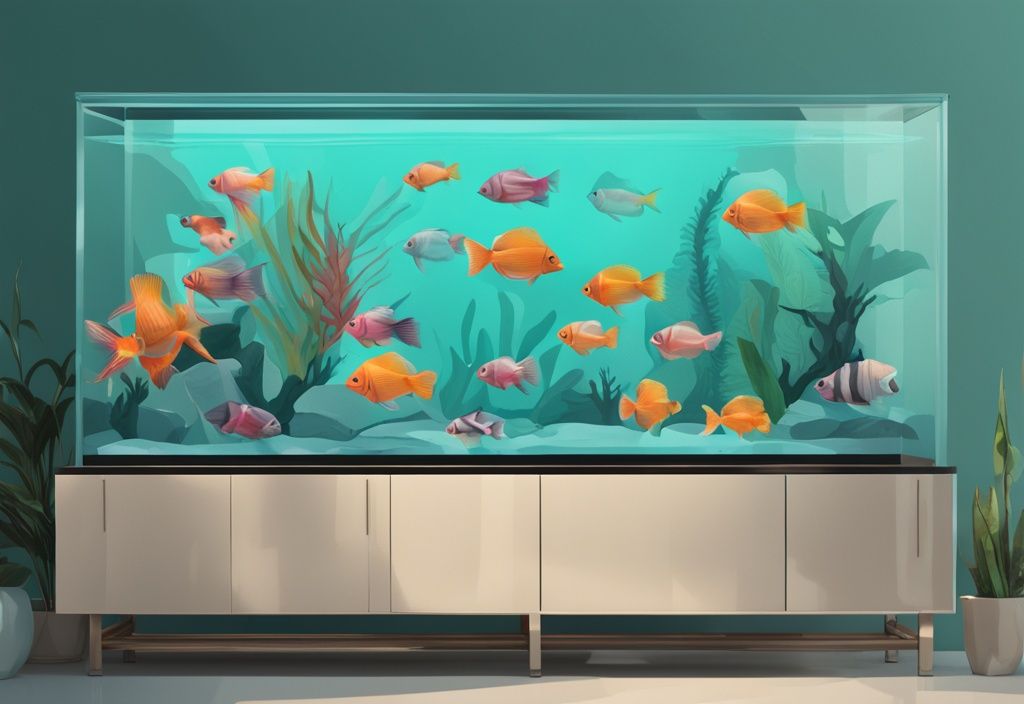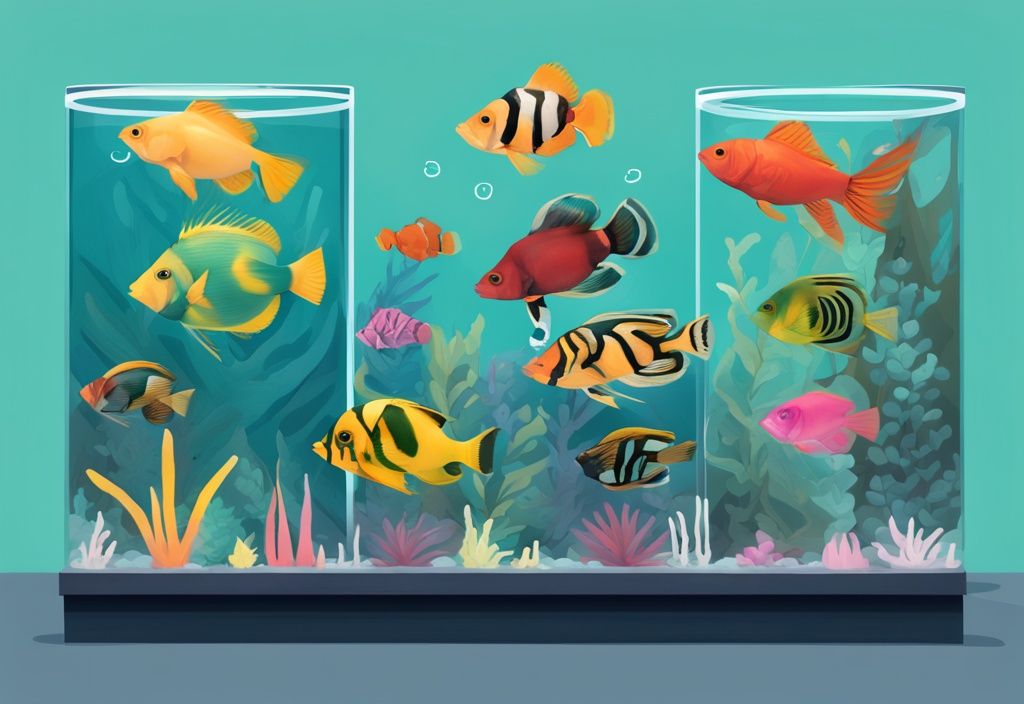Ever wondered, ‘How many fish can I comfortably accommodate in a 20-gallon tank?’ As a marine biologist with over two decades of hands-on experience, I’ve come across this question countless times. Believe it or not, the answer is not as simple as cramming as many guppies and goldfish as you can fit!
Considerations such as fish size, species, and even their behavior patterns play crucial roles in determining this perfect balance. In this article, we delve deep into these influential factors, alongside providing real-life examples and indispensable tips to keep your water-world habitat thriving.
So, gear up to dive into a sea of information designed to ensure your aquatic companions have their ideal space to flourish. Remember, a flourishing tank is more than a visual delight – it’s a testament to your commitment to these remarkable creatures!
Key Factors in Determining Fish Stocking Levels
Understanding how many fish can comfortably inhabit a 20-gallon tank involves multiple considerations. The main factors include fish size, species-specific needs, individual behaviors, and the bioload they generate. Assessing these elements ensures a lively, healthy environment for your aquatic friends.
- Fish size: Larger fish need more space.
- Fish species: Different species have varying needs and temperaments.
- Individual fish needs and behavior: Some fish are territorial or have other special requirements.
- Bioload: The amount of waste produced by fish and its impact on water quality.
Considering Fish Species and Size
When determining how many fish in a 20 gallon tank, the size and species of the fish are crucial factors. Imagine comparing a bustling metropolis to a quiet village. Larger or more active fish necessitate additional space compared to their smaller, less active counterparts. Fish with heavier bioloads or unique body shapes also require more room. Always consider the adult size of fish, as they will grow over time. This proactive approach ensures a comfortable and healthy environment as the fish mature.
The Role of Individual Fish Needs and Behavior
The individual needs and behaviors of fish significantly affect stocking levels. Some fish are territorial and may need more space to avoid conflicts. Schooling fish, like tetras, prefer to be in groups of six or more, which impacts the total number that can be kept. Thoroughly researching each species’ specific behaviors and requirements helps in creating a harmonious tank environment. Think of it like hosting a dinner party – you want all your guests to get along and have enough room to enjoy themselves!
Importance of Bioload and Water Quality
Managing bioload is essential to maintaining optimal water quality in a 20 gallon tank. Overstocking can lead to poor water quality, resulting in stress, disease, and sometimes death for the fish. The amount of waste that fish produce directly affects the tank’s water quality and increases the need for regular maintenance. A higher fish count translates to more waste, underscoring the importance of suitable stocking levels to maintain a healthy habitat.
Imagine your tank as a small, delicate ecosystem where balance is key. Regular checks and maintenance will keep your fish thriving in a clean environment.
The “One Inch of Fish per Gallon” Rule
This guideline is commonly referenced by aquarium hobbyists to determine how many fish can fit in a tank.
Understanding the Principle
The “one inch of fish per gallon” rule is a widely referenced guideline in the aquarium hobby. It suggests that for every gallon of water, you can keep one inch of fish. For instance, in a 20-gallon tank, according to the rule, you could theoretically stock up to 20 inches of fish. If you’re curious about relocating your aquarium, learn how to move a fish tank without emptying it safely and efficiently.
This principle is particularly fitting for small, slim-bodied species like neon tetras. These fish, which typically grow to about 1.5 inches, fit well within this guideline because they have modest space and filtration requirements. Imagine you have a school of neon tetras, their shimmering bodies easily swaying through the water, perfectly balanced with their environment. It’s a beautiful sight, isn’t it?
Its Limitation
However, the “one inch of fish per gallon” rule has notable limitations, especially when determining how many fish in a 20 gallon tank. Larger fish, or those with higher activity levels, require significantly more space than the rule would suggest. For instance, a 4-inch fish necessitates much more than just 4 gallons of water to thrive comfortably.
Additionally, fish that produce heavier bioloads—such as goldfish—demand larger environments to maintain water quality. The rule neglects the diverse needs, behaviors, and ecological needs of different species, making it less effective for varied or mixed-species aquariums.
Think about it: Just as humans can’t be comfortable in cramped spaces, fish too need room to swim, explore, and interact with their environment. Therefore, while useful as a starting point, aquarists should consider individual species requirements and tank dynamics for a more accurate stocking level. This approach ensures you create a thriving, balanced ecosystem where your aquatic friends can flourish.
Suitable Fish Species for a 20 Gallon Tank
Several types of fish are suitable for a 20-gallon tank, each bringing their own unique charm and vibrancy to your aquatic environment. Determining how many fish in a 20 gallon tank is crucial, considering the adult size, swimming behaviors, and specific space needs of each species.

Stocking Small Slim-Bodied Fish: Neon Tetras
Neon tetras are an excellent choice for a 20-gallon tank due to their small size and stunning coloration. As adults, these vibrant fish typically grow to about 1.5 inches in length, making them ideal for community tanks where space efficiency is key. In a well-maintained 20-gallon tank, around 15 neon tetras can comfortably inhabit the space. Their schooling nature ensures they thrive best in groups, creating a visually captivating display as they move in unison.
Stocking Medium-Sized Fish: Guppies, Platies, Mollies, Bettas, and Dwarf Gouramis
Several species of medium-sized fish are well-suited for a 20-gallon tank, with specific considerations for each species:
- Guppies: Guppies, with their vibrant colors and flowing tails, are a delightful addition to any tank. Being relatively small, you can keep between 10 to 12 guppies in a 20-gallon tank.
- Platies: Hardy and social, platies come in a wide array of colors. About 8 to 10 platies can comfortably inhabit a 20-gallon tank, provided there’s enough space for them to swim freely.
- Mollies: Mollies, slightly larger and more active than guppies and platies, require around 2 gallons of water per fish. Thus, you can keep about 10-12 mollies in a 20-gallon tank, accommodating their need for more swimming space.
- Bettas: Betta fish, known for their striking finnage, can coexist in a 20-gallon community tank under careful monitoring to prevent territorial disputes. One betta paired with other peaceful species works well.
- Dwarf Gouramis: Known for their peaceful nature and beautiful colors, a pair of dwarf gouramis can coexist with other small, peaceful fish species in a 20-gallon tank, provided there’s adequate space and territory.
When planning how many fish in a 20 gallon tank, always consider the adult size and space needs of each species. This ensures a balanced and healthy environment where all fish can thrive.
Practical Examples: Stocking Your 20 Gallon Tank
Stocking a 20-gallon tank requires careful planning and consideration to ensure a harmonious and healthy environment for your fish. Here are practical examples to guide you in creating a thriving aquatic habitat.
Scenario: Creating a Neon Tetra Community
Neon tetras are popular for their vibrant colors and peaceful nature, making them perfect for a community setup. When considering how many fish in a 20-gallon tank, it’s crucial to provide enough space for them to swim and exhibit natural behaviors.
- Ideal Stocking: Approximately 15 neon tetras
- Group Dynamics: Neon tetras are schooling fish that thrive in groups. Keeping them in schools helps reduce stress and encourages natural behavior.
- Swimming Space: Ensure the tank is aquascaped with open swimming areas and some plants for hiding spots, allowing the neon tetras to feel secure and comfortable.
Scenario: Building a Mixed Species Aquarium
Creating a community tank with a mix of species can be both exciting and challenging. Let’s consider a balanced approach to answer the question, “how many fish in a 20-gallon tank?” Combining species like neon tetras, guppies, and dwarf gouramis allows you to enjoy a diverse and vibrant aquatic environment.
-
Example Combination:
- 6 neon tetras
- 4 guppies
- 2 dwarf gouramis
-
Diverse Swimming Layers: This mix ensures coverage of various tank levels:
- Neon tetras primarily occupy mid-water.
- Guppies are active near the surface.
- Dwarf gouramis are versatile and can explore all levels.

- Compatibility: Ensure that the chosen species have compatible temperaments and similar water parameter requirements to prevent stress and aggression.
By carefully planning your stocking strategy and considering the specific needs of each species, you can create a thriving 20-gallon aquarium that showcases the beauty and diversity of the aquatic world.
Maintaining a Healthy 20 Gallon Tank
Ensuring a healthy and thriving environment for your fish in a 20-gallon tank involves regular maintenance and diligent monitoring. By understanding the importance of water changes, checking water parameters, and having proper filtration in place, you can create an optimal habitat for your aquatic friends. Here’s how to achieve this:
The Importance of Regular Water Changes
Regular water changes are vital for maintaining the water quality in your 20-gallon tank. Over time, waste, leftover food, and detritus accumulate, degrading water quality and potentially harming your fish. By consistently replacing 20-25% of the tank’s water weekly, harmful substances are removed, and essential nutrients are replenished, ensuring a stable, healthy environment.
Moreover, regular water changes prevent the build-up of toxins such as ammonia and nitrates, which can be detrimental to fish health. Imagine your fish swimming in a sparkling oasis rather than a murky swamp – that’s the magic of regular water changes.
Necessity of Checking Water Parameters
Monitoring water parameters is crucial for maintaining a balanced aquatic ecosystem in your 20-gallon tank. Essential parameters include pH, ammonia, nitrite, and nitrate levels. Each fish species has specific water chemistry requirements, so keeping these parameters within the appropriate ranges is vital for their well-being.
Frequent checks help detect imbalances early, allowing you to take corrective action before problems worsen. Consistent water conditions reduce stress on fish, promoting better health and longevity. Think of it like keeping a close eye on your home’s temperature and air quality to ensure everyone feels comfortable and safe.
Guideline for Proper Filtration
Adequate filtration is essential for high water quality in your 20-gallon tank. A suitable filter should handle at least four times the tank’s volume per hour – that’s an 80 gallons per hour capacity for a 20-gallon tank.
Effective filtration removes physical debris, excess food, and fish waste, while biological filtration converts harmful ammonia to nitrites and then to less harmful nitrates, maintaining a safe environment for your fish. Regularly cleaning and maintaining the filter ensures efficient operation, providing clear and healthy water for your aquatic inhabitants.
By adhering to these guidelines, you can ensure that your 20-gallon tank remains a safe and serene habitat, accommodating the ideal number of fish while safeguarding their health and well-being.
Top Tips for Achieving Optimal Stocking of Your 20 Gallon Tank
Gradual Introductions and Monitoring
Adding too many fish at once can upset your tank’s biological balance, leading to stress and potential health issues for your aquatic pets. Instead, gradually introduce new fish to your 20-gallon tank. Begin with a few individuals and allow the tank’s ecosystem to adjust.
This step-by-step approach helps in stabilizing the nitrogen cycle and avoiding spikes in ammonia and nitrite levels. For more detailed guidance on this process, check out our guide on how to cycle a fish tank. Consistent monitoring is essential. Observe fish behavior closely after introducing new residents. Watch for signs of stress such as erratic swimming, hiding, or aggressive behavior.
Regular health checks are crucial to detect early signs of disease or discomfort, allowing for timely interventions.
Safeguarding Against Overstocking
Avoiding overstocking is paramount to maintaining a healthy and thriving 20-gallon tank. Understanding each species’ needs and behavior is critical.
Not all fish are the same; some are more active and require more space, while others are territorial or social creatures with specific group requirements.

Always consider the adult size of the fish, not just their juvenile dimensions. Fish will grow, and you need to ensure that the tank can comfortably accommodate them once they reach maturity.
This foresight helps in preventing overcrowded environments, which can significantly degrade water quality and fish health.
In summary, achieving optimal stocking in a 20-gallon tank involves careful planning, gradual introductions, consistent monitoring, and thorough research into each species’ unique requirements.
Maintaining this balance creates a harmonious and healthy aquatic environment for your fish.
FAQ
How can I tell if my 20-gallon tank is overstocked?
Overstocking is a common challenge in maintaining a 20-gallon tank. One crucial sign to watch out for is deteriorating water quality. If you notice your fish appearing stressed—displaying behaviors like erratic swimming, excessive hiding, or aggression—it may indicate overstocking. Another clear signal is an uptick in diseases among your aquatic friends. Monitoring these indicators will help you maintain a balanced and healthy environment for your fish.
What filter is recommended for a 20-gallon tank?
When it comes to filtering a 20-gallon tank, efficiency is key. I recommend using a filter that can handle at least 80 gallons per hour. This capacity ensures optimal water quality by effectively managing the bioload. An appropriate filter not only keeps the environment clean but also supports the well-being of your fish by reducing stress and disease risk.
Can I mix different species in my 20-gallon tank?
Absolutely, you can mix different species in your 20-gallon tank. However, it’s essential to consider compatibility. Different fish have varied needs and behaviors, so it’s important to research whether they can coexist peacefully. Creating a harmonious community involves ensuring each species has adequate space, proper water conditions, and compatible tank mates.
How often should a 20-gallon tank be cleaned?
Maintaining a clean tank is crucial. I recommend performing partial water changes, about 20-25%, on a weekly basis. This practice helps control waste levels and keeps the water conditions stable. Additionally, don’t forget to service your filter regularly as it plays a pivotal role in sustaining a healthy environment for your fish.
What signs indicate my fish are stressed due to overstocking?
Recognizing stress in fish is vital to addressing overstocking issues. Signs of stress can include erratic swimming patterns, frequent hiding, uncharacteristic aggression, and a noticeable decline in appetite. These behaviors are signals that it’s time to assess and possibly reduce the number of fish in your tank to restore balance.
When should I add new fish to my 20-gallon tank?
Adding new fish to your 20-gallon tank should be a gradual process. Allow sufficient time between additions to let the tank’s biological environment adjust. This approach helps maintain stability, preventing stress and promoting a healthy habitat for all your fish. By pacing your additions, you ensure a thriving, balanced aquarium.
Conclusion
Determining how many fish in a 20-gallon tank can be housed involves a variety of factors that influence their wellbeing. The species and size of the fish play a major role, with larger or more active fish requiring more space. It’s essential to consider the adult size of the fish rather than their current size to ensure they have adequate room to grow. To maintain a healthy environment for your fish, it’s important to regularly clean the aquarium, including learning how to clean aquarium gravel.
Every fish species has unique behaviors and needs, making it imperative to research these specifics before adding them to the tank. The bioload, or the waste produced by the fish, substantially impacts water quality. An increased bioload from overstocking can lead to poor water conditions, stress, disease outbreaks, and even fatality.
Implementing the “one inch of fish per gallon” rule can provide a general guideline, particularly for small, slim-bodied fish like neon tetras. However, this rule has limitations and does not cater to larger or more active fish that require additional space. Maintaining a healthy 20-gallon tank requires regular upkeep and monitoring, including understanding the importance of water quality, which you can learn more about in this article on freshwater aquarium water quality.
Consistent water changes, usually 20-25% weekly, help sustain water quality. Monitoring water parameters, including pH, ammonia, nitrite, and nitrate, ensures a stable environment. Proper filtration is equally critical, with a recommended filter capacity of at least 80 gallons per hour for efficient water turnover.
Gradual introductions of new fish aid in maintaining the tank’s biological balance and reduce stress among inhabitants. Avoiding overstocking, understanding each species’ specific requirements, and accounting for growth and future needs are crucial practices.
Combining these factors with regular maintenance will ensure a thriving and healthy 20-gallon aquarium. In summary, the number of fish in a 20-gallon tank is not a one-size-fits-all scenario. A thoughtful approach considering fish size, bioload, and behavior, coupled with diligent tank care, will foster a vibrant and healthy aquatic environment.
